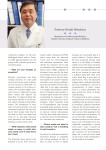
0000288002 21 / 27
10秒後にBOOKのページに移動します
verification complete, we will start full-fledged clinical trials in February 2019, splitting patients into two groups of 20, a placebo group and a treatment group. ──What are your thoughts on prevention? Exercise, conversation and brain training exercises are some good ways to prevent the onset of dementia. The increase in blood flow is a common element to all of these activities. My treatment applies ultrasonic waves to effectively increase blood vessels, and improve the blood flow. An improved blood flow help reduce amyloid β and tau protein, shown through chronic inflammation. The introduction of ultrasonic wave-led preventive care and treatments could pave the way for a future where people could drop by the clinic on their way home from work for an hour-long ultrasonic wave preventive care session while listening to their favorite music. ──While ultrasonic waves sound simple on paper, in reality ultrasonic waves come in many forms, don’t they? The ultrasonic waves used to treat dementia is in the form of low intensity pulsed ultrasound (LIPUS), which varies from the ultrasonic waves used for echocardiograms and abdominal ultrasounds. Additionally, the ultrasonic waves used are matched to the conditions of the human brain. Simply applying the ultrasonic waves used for the heart to the temple will not have an effect. What is important is that low intensity impulse wave and low intensity ultrasonic waves work according to the same mechanism. We have identified that if you apply stimulation to a complex cell membrane consisting of β1-integrin and Caveolin-1, a chemical signal reaches the nucleus accentuating the expression of the essential factor required for vascularization, which eventually leads to NO (endothelium type nitrogen monoxide) being produced, increasing and expanding the blood vessels to alleviate chronic inflammation. This has been made clear down to a molecular level, with development on a treatment now underway. ──Clinical results are about to start coming in. That’s something to look forward to. In contrast to medicinal treatments, ultrasound therapy is completely safe, having produced no side effects in terms or liver or kidney damage, and I personally hope it is proved effective. Further, where I feel that ultrasound therapy really excels is in the ability to irradiate specific areas of the heart and brain and only have areas lacking in blood flow react, meaning that blood vessels do not increase in areas with a sufficient blood flow. Only areas where blood flow is poor show an improvement, with vascularization stopped when a sufficient blood flow has been established to prevent of overproduction of blood vessels. This is a critical phenomena that goes beyond the realm of human understanding. The human body is said to contain a notable amount of latent self-healing capabilities that go unused. Curiously, providing a physical stimulation using the low intensity pulsed ultrasound we have discovered helps patients recover while keeping to their own organization and program. All we do is provide a helping hand. Dementia patients are now increasing at a rate of 10 million every year worldwide, representing a serious social issue. I hope to spread the application of this ultrasound therapy treatment not just throughout Japan, but to the rest of the world as well as part of my contribution to the betterment of mankind. Professor Hiroaki Shimokawa Department of Cardiovascular Medicine, Tohoku University Graduate School of Medicine 5